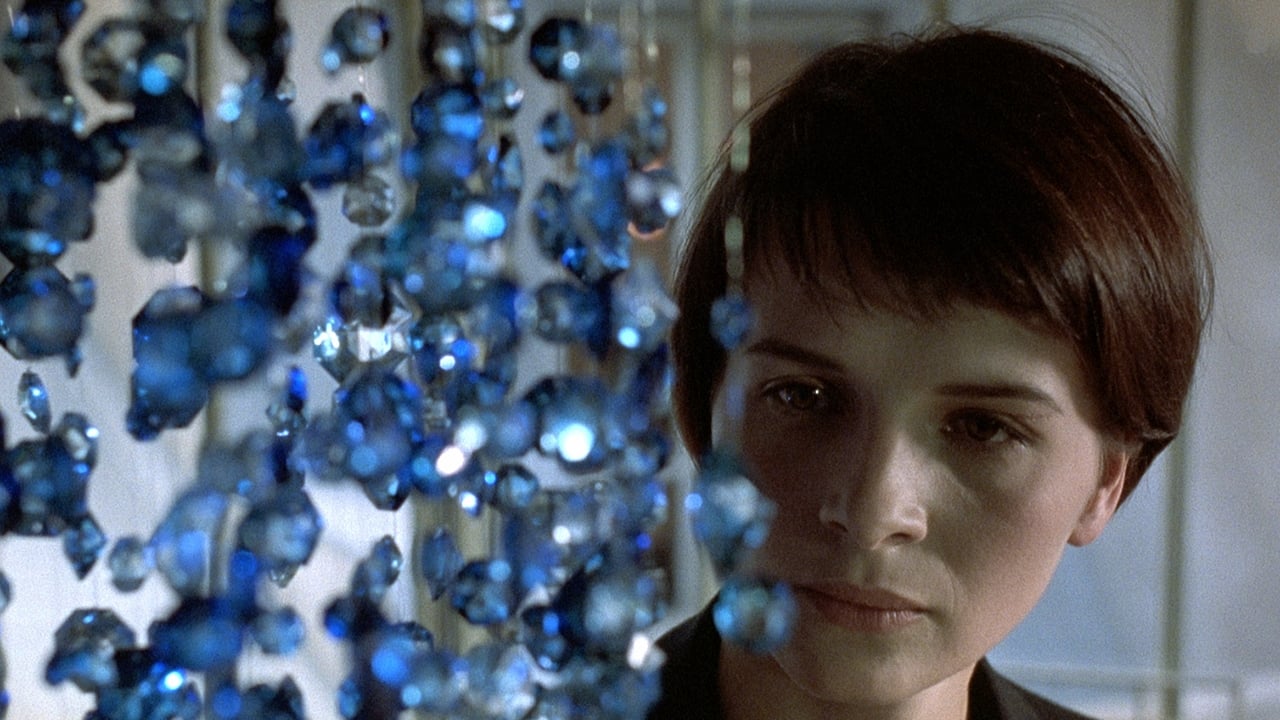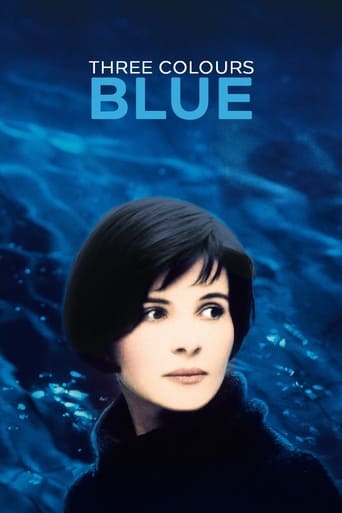

I feel I've discovered something profound by learning of Krzysztof Kieslowski's trilogy of films in 'Three Colors'. It's virtually impossible to find a completely original concept in movies today, yet the Polish director has achieved something in his work that creates a long lasting impression. 'Blue' establishes it's theme of liberty through loss early in the story, as we follow the post-accident life of the picture's protagonist Julie Vignon (Juliette Binoche), as she tries to cope with the loss of a husband and young daughter. Julie goes to the extreme of selling off all her possessions and moving to the city where she can live alone and escape her memories, along with friends and lovers who no longer have any meaning for her. This life of self imposed solitary confinement will not last long, as the kind hearted young woman finds it impossible not to come to the aid of others in distress or turmoil. I found this to be a strangely fascinating film experience. The theme of 'blue' repetitively appears throughout the story - the blue room that Julie orders emptied at the family home, the crystal strands of the mobile she takes with her to the city, the blue lollipop and wrapper, and the swimming pool she takes laps in to relieve her innate stress at being alive. I'm wondering if there's some hidden symbolism with the pool; Julie never laps it lengthwise, she only swims from one side to the other. I was also very curious about the scene where Julie observes three (three again) thugs beating up a man who gets away and seeks refuge in her apartment building. One expects that she come to the man's aid, but instead she's locked out of her apartment for the night, and the man is nowhere to be found. This appears to be a Kieslowski trademark of introducing characters in his films that are unconnected to the main theme, and wind up superfluous to the story. Not exactly a maguffin or a red herring, but a uniquely different kind of creative touch that one doesn't experience in other movies. I began watching these films out of order, having already seen "Three Colors:Red", but not commenting on it until I've seen the director's 'Blue' and 'White' movies to see if there's a connecting thread. It seems implicit, while other reviewers make note of elements that come together by the final installment. Though 'Red' seems to stand alone well enough by itself with no recurring characters, I did pick up on a hint in 'Blue', and will have to see how the thread plays out. So more on that at a later time.
... View More"Three Colors: Blue" is a film about Julie (Juliette Binoche) loses her husband, a famous composer, and her young daughter in a car wreck. The film follows the weeks after this incident, and how she tries to cope with their deaths. It is a film about grief and loss, and the entirety of this film is spent focusing on Julie, and her enigmatic, but not too obscure thoughts and feelings during her grieving process. Towards the beginning, it seems she feels nothing. Her husband and daughter may have been the only people she really loved, so their death has forced Julie to stare into the void and contemplate the meaning of her existence, if there is any. She clearly wants to forget about them completely and try to start anew, selling all of their belongings that remind her of them, including her house, and moving away. She plays her husband's unfinished symphony, and when she gets to the unfinished emptiness, blue light crowds the screen and she is suddenly reminded of his death. She destroys her husband's unfinished symphony, believing it cannot possibly be finished by anyone because no one can replace him. She does, however, bring with her the blue light that was in one of her rooms, showing she doesn't yet have the strength to completely leave him behind.Blue is obviously a very important color in this film, and it often represents longing and loneliness when it is used. For instance, Julie often goes to the pool on her own, and the water is often illuminating blue. She keeps coming back to it because she can't move past her family's death, no matter how hard she tries. The only other family member she visits is her mother, who barely remembers who she is. The use of color is pretty ingenious in many scenes, with green also symbolizing content occasionally. The music enriches this sense of longing, with Julie's husband's unfinished symphony being used again and again, each time with the screen fading to black mid-scene and fading back to the same scene. This symphony is a constant reminder of his absence, and the hole this has caused in her life. The cinematography is restrained and beautiful, perfectly exploring this character that is so perfectly portrayed by Juliette Binoche. Her performance in this film is just restrained enough to give us a sense of her true feelings while also seeming constantly complex and interesting. The end is one that I will probably think about for a long time after viewing. There are hints that she may find a way to move past her grief, but there are also hits that she may never fully recover. It is clear that she wants to move past it, but continues to be pulled back down into her depression, and it seems part of her wants to continue thinking about him and wallowing in her misery forever, because it is all she has left to do. This is one of those rare films where the entire thing is a deep exploration of one character, almost through the visuals, editing, music, and Binoche's performance alone. There is a lot of symbolism to unpack and deliberate over. It truly takes a hold of the film medium to deliver a complex, thoughtful, and constantly mysterious study of one character dealing with grief. It's biggest strength is its incredibly enigmatic and unpredictable nature, yet this was occasionally a flaw upon first viewing. This is a film I will definitely watch more than once, that much I can say.
... View MoreFor cinema lovers this is an incredible movie , Juliette Binoche plays one of the best roles in her lifetime i think. The movie is great, and watching it many times is a must to understand all the hints of the Great director Kieslowski. Amazing picture , every cadre in the scene is beautiful well thought off and very meaningful.Even though this movie is within the frame of a three-movies series , i personally happen to admire this one the most . However , the other three , three colors white and red are also incredible movies. They are almost at the same high point of being interesting. Simply i believe anything of Kieslowski the director is great , he's an amazing talent that one must follow and apprehend.
... View MoreThough interestingly filmed, in that Kieslowski way, this film is disappointingly predictable and shallow in its layering, and in the exposition, such as it is, of its supposed theme of "liberty." And how are we to imagine that the composer of such superficial and badly composed music was famous? A failed attempt to imitate some sombre late 19th- or early 20th-century style? But it is much too banal for that, and perhaps some sort of monumental-sounding minimalist approach was intended. A film in which a composer and his (?) music figures prominently must make a better attempt to provide a convincing score. Binoche's portrayal of emotional deadness was not convincing, either. "The Decalogue" is a much greater work.
... View More